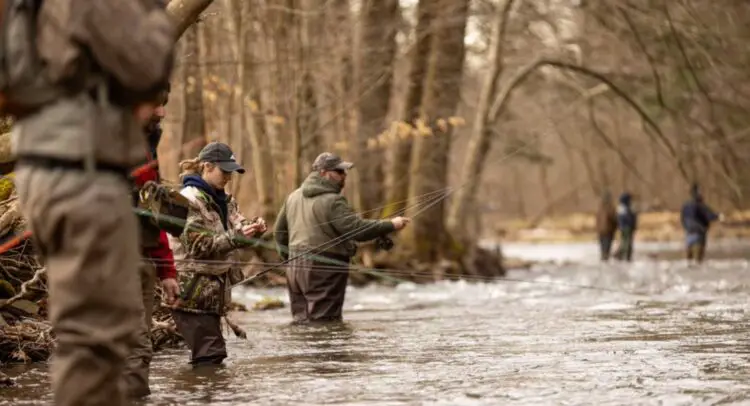HARRISBURG, Pa. – The Pennsylvania Fish and Boat Commission (PFBC) reminds anglers that the statewide Opening Day of Trout Season is this Saturday, April 6.
(Photo courtesy Stover Photography.)
Anglers may begin fishing at 8 a.m.
While the opening day of the season is a cherished tradition for anglers, many who travel great distances and look forward to spending time with family and friends, it should be noted that stocked trout fishing opportunities will continue to be abundant statewide with replenishment stockings occurring throughout the spring.
Throughout the 2024 season, the PFBC will stock approximately 3.2 million adult trout in 697 streams and 129 lakes open to public angling.
These figures, which are consistent with the number of trout stocked over the past decade, include approximately 2.3 million Rainbow Trout; 707,000 Brown Trout; and 168,000 Brook Trout. As with past practice, the average size of the trout produced for stocking is 11 inches in length with an average weight of .58 pounds.
The PFBC will also stock approximately 70,000 trophy-sized trout measuring 14″-20″.
Approximately 14,000 golden Rainbow Trout, weighing an average of 1.5 pounds, will also be stocked during preseason and in-season stockings. PFBC partner cooperative nurseries sponsored by sportsmen’s groups and other organizations will combine to raise an additional one million trout that will be stocked into public waterways throughout the trout season.
During the regular trout season (Opening Day through Labor Day), anglers may keep up to five trout (combined species) per day measuring at least seven inches long. During an extended season from September 3, 2024, through February 18, 2025, the daily limit is three trout.
To purchase a fishing license and trout permit, review trout stocking schedules, and find trout fishing tips, visit Fishandboat.com, or use the FishBoatPA mobile app.
Anglers are no longer required to display a printed copy of their fishing license on the outside of their clothing and may simply store their license digitally on their phones.
Be Aware of Weather Conditions
Due to recent rain across Pennsylvania, many waterways may be higher than normal on opening day of trout season. Anglers should keep safety in mind and adjust their fishing plans, as necessary.
While most waters have already been stocked with trout, due to conditions, some stockings scheduled for this week may be postponed. In advance of their fishing adventure, anglers should reference the Trout Stocking Schedule on the PFBC website (Fishandboat.com), to make sure the water they plan to visit has been stocked with trout.
Wading and boating should be avoided if waters are running high and muddy and the streambed is not visible. If stream conditions are not favorable, consider fishing at a lake.
What Happens to Trout in High Water?
Fish survive high water and flood conditions by seeking out refuge areas within streams. During periods of high water, fish move towards the banks to find calmer water and lower velocities. Fish avoid the fast moving surface and hold behind rocks and submerged woody debris to find calmer current breaks and may rest on the stream bed. Fish may move into smaller tributaries during periods of high water and return to the larger waters when flows recede.
A high-water event may cause trout to move, but they don’t suddenly get washed downstream. Fish may move either downstream or upstream in search of a refuge area. High flows can help to distribute trout that have been recently stocked; however, studies show that most stocked trout will remain in place if they are close to adequate habitat or a large pool that provides depth and cover.
A long period of muddy water can irritate fish gills and make foraging more difficult. However, anglers should continue to fish on their favorite stream as flows recede and the water clears. Hatchery trout are not as adept at finding food as wild trout, and fishing can be very good when the fish begin actively feeding again.
Fishing from a boat?
Anglers who plan to fish from a boat on Opening Day of Trout Season, and for the next several weeks, are reminded that the PFBC’s cold weather life jacket requirement is in effect from November 1 through April 30.
Under this rule, anyone aboard a boat 16 feet or less, including all canoes and kayaks, is required to wear a life jacket. Children ages 12 and under are always required to wear a life jacket while boating in Pennsylvania.
Catch-and-Release Fishing Techniques
The PFBC reminds anglers of proper catch-and-release fishing techniques when harvest is not permitted or when anglers choose to practice catch-and-release fishing during trout season. The techniques listed below will ensure that released fish have the best chance to survive and contribute to future angling enjoyment.
- Land your fish as quickly as possible and don’t play the fish to exhaustion. Excessive stress and exhaustion increase post-release mortality.
- Use a landing net (rubber or rubberized mesh is best) to better control your catch and reduce trauma associated with handling.
- Keep the fish in the water as much as possible. The chance of a fish being injured increases the longer it is held out of the water.
- Wet your hands, your net, and other materials that touch the fish. Don’t handle fish with a towel or rag. This helps to keep a fish’s protective mucus or slime layer in place.
- Hold the fish upside down while removing the hook. This can calm the fish for quicker unhooking and release.
- Use hemostats or long nose pliers to aid in removing a hook quickly and safely. Use barbless hooks or pinch down barbs on existing hooks with small pliers to make removing hooks easier.
- When not possible to remove the hook without harming the fish, cut the line or harvest to eat (subject to season, length, and creel limits).
- Avoid contact with the gills and do not handle by placing your fingers under the operculum (gill cover).
- Hold the fish upright underwater after unhooking until it can swim away on its own. If necessary, gently hold the fish out of strong current until it revives.


